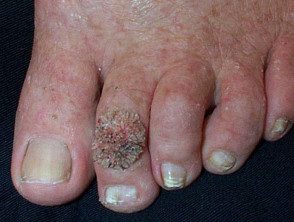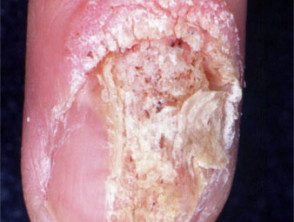What is a viral wart?
A viral wart is a very common growth of the skin caused by infection with human papilloma virus (HPV). A wart is also called a wart, and warty injuries can be described as warty.
Viral warts

Viral warts

Nail wart

Viral warts
See more images of viral warts.
Who gets viral warts?
Warts are particularly common in:
- School-age children, but they can arise at any age
- Eczema, due to a defective skin barrier
- People immunosuppressed with medications such as azathioprine or cyclosporine, or with human immunodeficiency virus (HIV) infection. In these patients, warts may never go away, despite treatment.
What causes viral warts?
The warts are due to infection with the human papilloma virus (HPV), a DNA virus. Over 100 HPV subtypes are known, leading to a variety of presentations. Infection occurs in the superficial layers of the epidermiscausing proliferation of the keratinocytes (skin cells) and hyperkeratosis - The wart. The most common subtypes of HPV are types 2, 3, 4, 27, 29, and 57.
HPV is transmitted by direct skin-to-skin contact or autoinoculation. This means that if a wart is scratched or scraped, the viral particles can spread to another area of the skin. the incubation The period can be up to twelve months.
What are the clinical characteristics of viral warts?
Cutaneous Viral warts have a hard, keratinous surface. A small black dot can be seen in the middle of each scaly spot due to a intracorneal hemorrhage.
Common wart
Common warts present as papules with a rough papillomatous and hyperkeratotic Surface that varies in size from 1 mm to more than 1 cm. They arise most frequently on the back of the fingers and toes, around the nail—Where they can distort nail growth — and on the knees. Sometimes they look like cauliflower; These are known as butcher warts.
Plant wart
Plantar warts (warts) include painful and internally growing 'myrmecia' on the sole of the foot, and groups of less painful mosaic warts. Plantar epidermoid cysts are associated with warts. Persistent plantar warts can rarely be complicated by wart development carcinoma.
Flat wart
Flat warts have a flat surface. The most common sites are the face, hands, and pimples. They are often numerous. They may be inoculated shaving or scratching to make them appear on a linear distribution (pseudo-Koebner response). Flat warts are mainly caused by HPV types 3 and 10.
Filiform wart
Filiform warts are on a stem long as a thread. They usually appear on the face. They are also described as digitate (like a finger).
Mucous membrane wart
Oral warts can affect the lips and even inside the cheeks, where they can be called scaly cell papillomas. They are softer than skin warts. See also anogenital warts
Viral warts complications.
Viral warts are very extended in people with the rare inherited disorder verruciform epidermodysplasia.
Evil one The change is rare in common warts and causes warty carcinoma.
Oncogenic strains of HPV, the cause of some anogenital warts and warts that arise in the oropharynx, are responsible for intraepithelial and invader neoplastic injuries including cervical, anal, penis and vulva Cancer.
How is a viral wart diagnosed?
Tests are rarely needed to diagnose viral warts, as they are very common and have a characteristic appearance.
- Point points (coagulated capillaries) are revealed when the top of the wart is removed.
- A Dermoscopic examination is sometimes helpful in distinguishing viral warts from other warty lesions such as seborrheic keratosis and skin cancer.
- Sometimes viral warts are diagnosed on the skin. biopsy. the histopathological The characteristics of the common wart differ from those of flat warts.
What is the treatment for viral warts?
Many people don't bother treating viral warts because treatment can be more uncomfortable than warts; they are almost never a serious problem. Warts that are very small and unproblematic can be left alone and, in some cases, will regress on their own.
However, warts can be painful and often look ugly, causing embarrassment.
To get rid of them, we have to stimulate the body's immune system to attack the wart virus. Persistence with treatment and patience are essential!
Current treatment
Topical treatment includes wart paints that contain salicylic acid or similar compounds, which work by removing dead skin cells.
The paint is applied once a day. Treatment with wart paint generally makes the wart smaller and less uncomfortable; The 70% of warts resolve within twelve weeks of daily applications.
- Soften the wart by soaking it in a bath or container of hot soapy water.
- Rub the wart surface with a piece of pumice stone or an emery file.
- Apply wart paint or gel accurately, allowing it to dry.
- Cover with plaster or tape.
If the wart paint irritates the skin, discontinue treatment until the discomfort has subsided, then start again as indicated above. Take care to keep the chemical out of normal skin.
Cryotherapy
Cryotherapy is repeated at intervals of one to two weeks. It is uncomfortable and can cause blisters for several days or weeks. Success is on the order of the 70% after 3 to 4 months of regular freezing.
A strong freeze with liquid nitrogen can cause a permanent white mark or scar. It can also cause temporary numbness.
A spray spray with a mixture of dimethyl ether and propane (DMEP) you can buy on the counter to freeze common and plantar warts. Read and follow the instructions carefully.
The combination of immunotherapy with cryotherapy reduces the number of cryotherapy sessions.
Electrosurgery
Electrosurgery (curettage and cauterization) is used for large, resistant warts. Local bass anesthetic, growth is cut and the base burns. The wound heals in two weeks or more; Even then the wart 20% can be expected to recur in a few months. This treatment leaves a permanent scar.
Other treatments
Other experimental treatments for recurrentStrong or extensive warts include:
-
Current retinoidslike tretinoin cream or adapalene gel
- Immunomodulator, imiquimod cream
- Fluorouracil cream
- Bleomycin injections
-
Oral retinoids
-
Pulsed dye To be destruction of food blood vessels
- Photodynamic therapy
-
Laser vaporization
- H2 receiver antagonists
- Oral zinc oxide and zinc sulfate
- Applications of raw garlic or tea tree oil
- Immune stimulation using diphencyprone, or squaric acid
- Immunotherapy with Candida albicans or tuberculin PPD
- Hypnosis
- Hyperthermia, for example, using heat patch
- Occlusion with adhesive tape
How can viral warts be prevented?
HPV vaccines are available to prevent anogenital warts. Anecdotally, these have been reported to cause the removal of nongenital warts in some people without definitive evidence that the vaccine is the cause of remission. In New Zealand, 12-year-old boys and girls are vaccinated against nine strains of HPV.
What is the prognosis for viral warts?
No treatment is universally effective in eradicating viral warts. In children, even without treatment, 50% from warts disappear in six months and 90% disappear in 2 years. They are more persistent in adults, but disappear over time. They are likely to reappear in immunosuppressed patients, for example, organs transplant recipients Reappearance It is more frequent in tobacco smokers.

